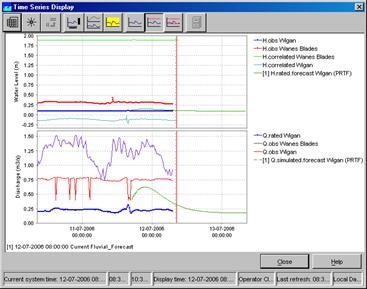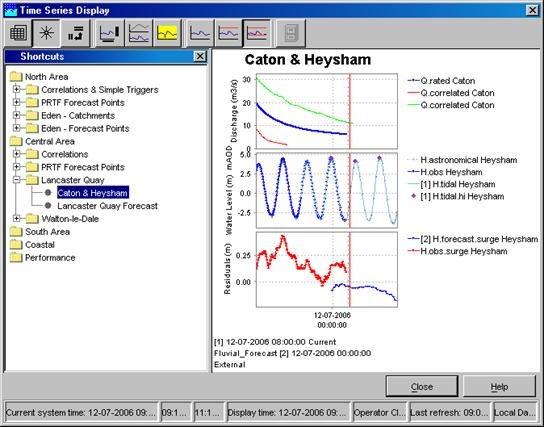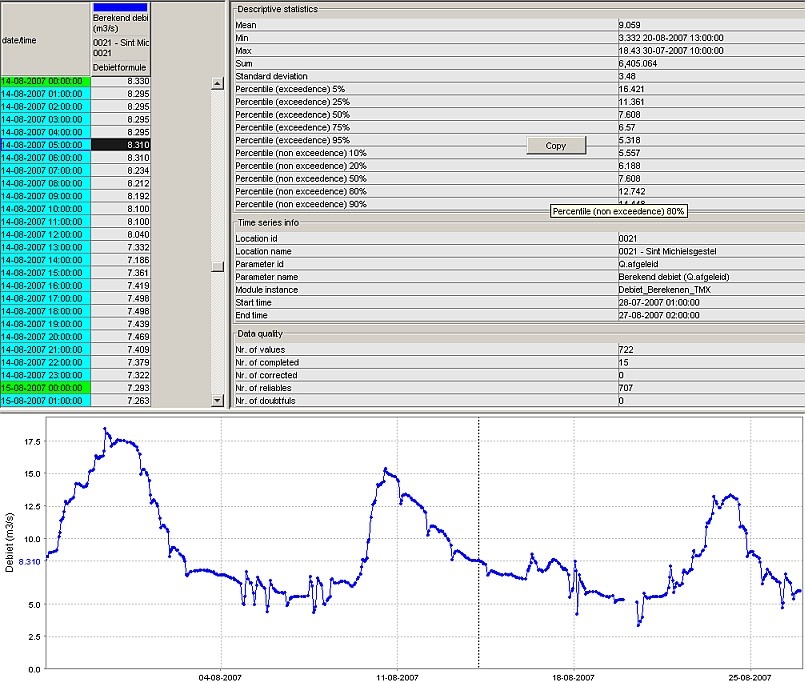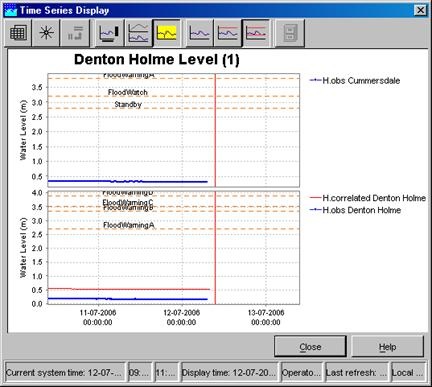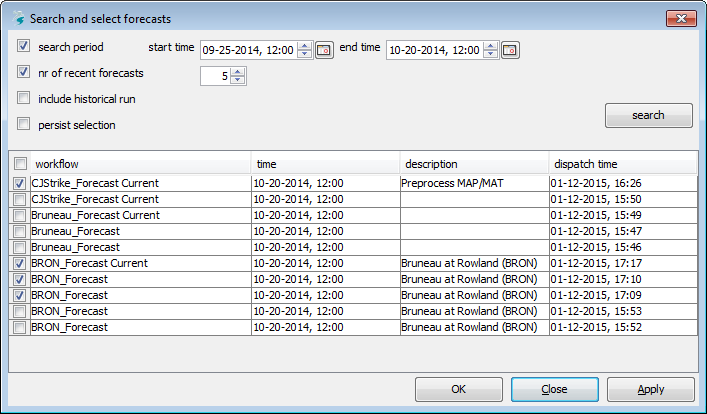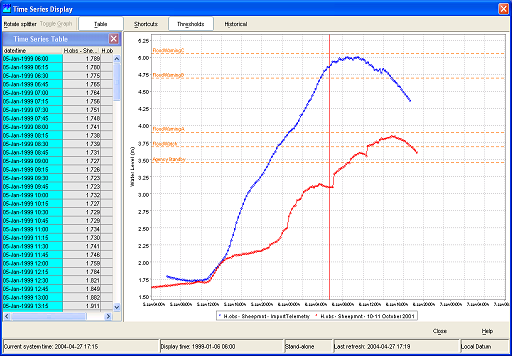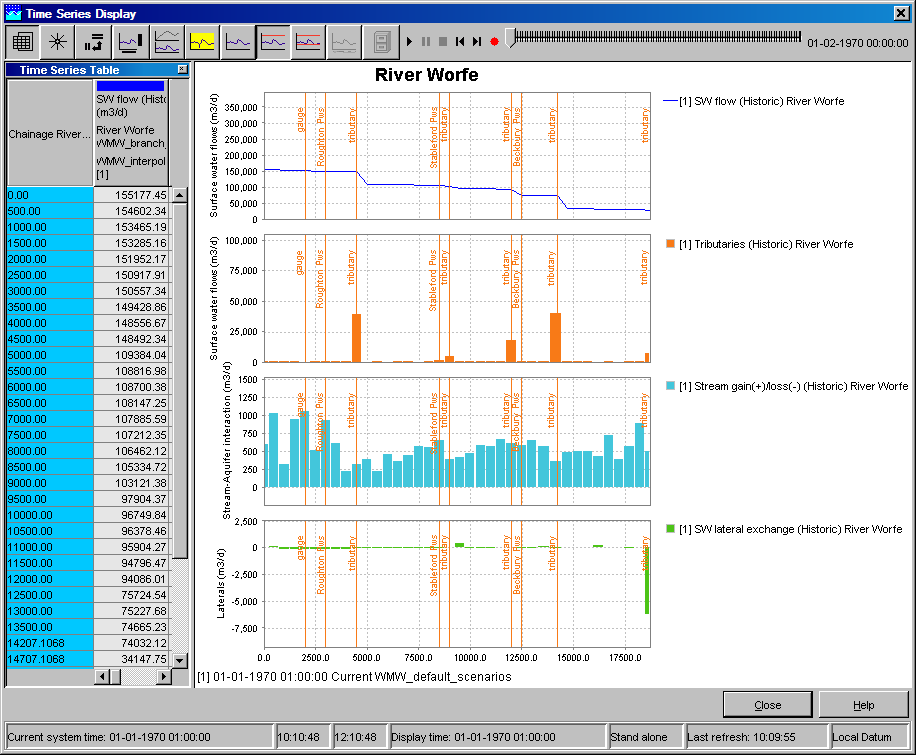Data Display and Data Editor
The Data Display and Data Editor offer graphical displays for presenting and editing of data. Both have nearly the same functionality but only the Data Editor allows you to edit data. In addition, the data editor can only be opened once while multiple instances of the data display can be opened.
This display offers the following features:
- Display of time series in:
- graphs (scalar/longitudinal profiles)
- tables (scalar/longitudinal profiles)
- Tabular data editor
- Display of actual data with:
- Historical events
- Threshold levels
Data is displayed in a table and a graph simultaneously. The splitter between the table and the graph can be moved to modify the display. Select the data series, that should be displayed with help of the List Boxes and/or the Map Display (see also Filters ).
Decimals for the reference values (ticks) in the chart autorange between 0 and 6, always using the lowest amount necessary to differentiate between ticks.
When the display is started through the FEWS Tools menu item Data Editor , data can be edited and the edited data can be stored in the FEWS data base. When the display is started through the FEWS Tools menu item Data Display or through the FEWS toolbar, the data can only be viewed.
1.1 Data Display
Press the [Data Display ] button on the toolbar to present graphs displaying the data. The splitter is normally positioned on the left of the display.
When data series of different data types have been selected, the data will be presented in different subplots with the data series of a single data type merged into one subplot.
The data in the graph is updated automatically in case new data becomes available. Below the graph the workflows are listed that generated the forecast time series in the graph. Their numbers are used in the graph legend and table headers too.
The following buttons are used in the Time Series Display:
Table
By clicking this button the time series in the graph is also displayed in tabular format. Please note that in case you like to edit data, you have to select the Data Editor from the Tools menu (see section 4.3).
Selecting the small arrow at the right of the icon shows the next menu:
| function | description |
|---|---|
| Validation | shows a separate column with the validation flags |
| Users | shows a separate column with the user names of editted values |
| Comments | shows a separate column with the comments |
| Units | shows in the header the unit of the parameter |
| Location Names | shows in the header the location name |
| Location Ids | shows in the header the location ID |
| Module | shows in the header the moduleInstanceId |
| Column statistics | shows between the header and the table statistics of the values in the current relativeViewPeriod, like mean, sum, min, max |
| Threshold crossing | shows in the cells (on the left side) a small bar with a color according to the threshold definition, that indicates a threshold crossing |
| Normal | shows the values in a normal table, so all times have a row |
| Days | shows the values in an aggregated way, so that each day gets its own column. Usefull to series with for example an hourly time step. |
| Weeks | shows the values in an aggregated way, so that each week gets its own column. Usefull to series with for example a daily time step. |
| Months | shows the values in an aggregated way, so that each month gets its own column. Usefull to series with for example daily time step. |
| Years | shows the values in an aggregated way, so that each year gets its own column. Usefull to series with for example monthly time step. |
| Show empty RVP series | shows/hides the series which are empty in the current viewperiod. Usefull while using shortcuts or thumbnails. |
| Show empty complete series | shows/hides the series which are completely empty. Usefull while using shortcuts or thumbnails. |
| Time order reversed | Shows the times in reversed order, so from new to old |
Shortcuts
Display templates are available for rapid assessment of data. The templates can be activated by clicking the above mentioned button. The left side of the display shows the available shortcuts in a pre-configured grouping.
The data shown via the Shortcuts belong to the forecasts selected in the Forecasts panel of the FEWS Explorer. Please note that the current forecast is always displayed in the graphs.
Graph
This button can be used to hide or show the graph. If the table was not yet selected, it will show up.
Selecting the small arrow at the right of the icon shows the next menu:
Descriptive statistics
This button will add a table to the display with descriptive statistical information. The statistics only appear if a column in the table is selected. Use the right mouse button to copy this table to the clipboard for pasting in Excel.
Statistical Functionality available (if configured):
- Mean
- Min (with date)
- Max (with date)
- Sum
- Standard deviation
- Percentiles (exceedance and non-exceedance)
Time series information:
- Location id
- Location name
- Parameter id
- Parameter name
- Module instance
- Start time
- End time
Data quality information:
- Number of values
- Number of completed values
- Number of corrected values
- Number of doubtful values
- Number of missing values
- Number of reliable values
- Number of unreliable values
Validation Rules (hidable panel)
Since 2016.02 button is added to show (or hide) a panel that show the validation criteria for the selected time series on the selected time step
Opening this panel will automatically hide descriptive statistics panel when open
Rotate Splitter
With this button the splitter between table and graph can be placed in a horizontal position. Clicking the same button again returns the splitter to its default vertical position.
Rotate Legend
This button can be used to place the graph legend underneath the graph. Clicking the same button again returns the legend to its default position at the right hand side of the graph.
Toggle Graph
When multiple data series are selected for a single data type (parameter), the graphs will be placed in one subplot of the graph. This sometimes complicates the analysis of time series with different data ranges. By clicking the above mentioned button you can change the layout of the chart:
- Merged into a single graph
- Stacked in different subplots
Scale to show unreliable Data
This button can be used to focus on time intervals with unreliable data within the selected time series. Data is marked as unreliable, if values exceed hard limits.
Show no Thresholds
By clicking this button all pre-configured thresholds which can also be shown in the graphs with the selected time series disappear.
Scale to show relevant Thresholds
With this option the graph is scaled in such a way, that relevant thresholds (the closest threshold values) are displayed together with the selected time series in the graph.
Scale to show all Thresholds
This button can be used to show all pre-configured thresholds of a certain parameter at the selected location(s). This means that all thresholds levels (e.g. Standby, Flood Watch, Flood Warning and Severe Flood Warning) are displayed in the graph.
Show data labels
Clicking the 'Show data labels' will you to display quality flags for the data you are presenting. The information is shown at the bottom of the screen.
The following colour codes have been used:
- the upper line indicates the origin of the data
- original data: no line is displayed
- automatically corrected data (original data flagged as unreliable and automatically interpolated): blue line
- automatically completed data (original data is missing and interpolated by system): magenta line
- manual corrected data (original data edited by a user): dark blue line
- manual completed data (filled up by a user): dark magenta line
- the middle line indicates the quality of the data
- reliable data: no line is displayed
- doubtful data: light yellow
- unreliable data: dark yellow
- the lower line indicates where comments have been added to the data
- no comment: no line is displayed
- comment available: dark red
The lines are displayed under the data points. The colours correspond with the colouring used in the tables.
Statistical Functions
If switched on in the configuration. This functionality works independently from the descriptive statistics table.
The available statistical functions can be selected from the drop-down box in the button bar. The selected function will act on the timeseries that are currently selected by in the timeseries dialogue. The result of the statistical analysis will be shown in the timeseries dialogue window. Follow this link for a description of all available statistical functions.
Search and Select Forecast
Displays in FEWS by default only show current approved forecasts. Previous forecasts can be shown if you approve them in the Forecast Management Display, or by using this “search and select forecasts” option.
Historical Events
With this button historical events can be activated (provided that they are pre-configured). They will be displayed in the same graph to enable a comparison with the actual timeseries. Further explanation is given below.
Display time
To change the view period in the graph, the field Display time in the Status Bar below the graph should be double clicked. The display time can now be changed with help of the menu. Press [OK ] to accept the changed view period. The next time the chart is opened the original configured display time will be used again.
Datum Toggle
The Datum Toggle at the lower right hand corner of the display allows levels to be displayed with reference to Local Datum or mAOD .
Navigating in Graphs
Zooming in and out can be done with help of the scroll wheel of the mouse. Scrolling away from the user results in zooming in while scrolling towards the user results in zooming out.
Zooming is also possible by selecting a zoom range. Drag the mouse holding down the right button to form a rectangular area to zoom in to.
When clicking the right mouse button, the dropdown menu presented below appears. The menu gives you some additional options.
Save As
You can save the graph to file with this option.
This option allows you to print the graph.
Zoom in / out
You can select to zoom in and out along one or both axis with this option.
Allow Vertical / Horizontal Axis Zoom
You can select to allow for zooming in and out along one of the axis with this option.
Auto Range
This feature allows you the set automatic scaling along one or both axis.
Data Editor
The Graph and Editor display has a table and an edit mode.
The most left column shows the date and time of the data. The period displayed spans the overall period defined in the filters for all time series.
The colours in the headings of the columns correspond with the line colour in the graph.
In the date/time column different colours are used to provide a logical meaning to certain important moments:
- Light blue: historical data, either observed or hindcast (data before T~0~ )
- Dark blue: forecast data (data after T~0~ )
For the data columns the background colour is used to indicate the quality of the data, identified by the data flags set of the Validation utility. Further, an indication of the editability of the data is given by the the background colour. The meaning of the background colours in the data fields is:
- White: reliable, editable
- Light yellow: doubtful
- Bright yellow: unreliable
- Gray: not editable
The font colour in the data fields indicates the data origin. Following colours are used:
- Black: original data
- Blue: corrected (original data flagged "Unreliable" and interpolated)
- Magenta: completed (original data missing and interpolated)
The edit mode can be enabled from the toolbar with the Enable Edit mode button. Data (only those with a white background) can be edited by double clicking a field in the column. Editing may be done in the table directly. The result of an edit action is directly displayed in the corresponding graph. Manually corrected data will be saved to the database by disabling the Edit mode again from the toolbar. A pop-up will ask to save the edited data to the database. With [OK ] the data is saved, [NO ] the data is not saved and with [Cancel ] changes will be undone.
Through manual editing of data, the source of the data changes from original to corrected. The font colour used for edited data is blue to indicate that it is completed data. The background colour remains white, as the data has not yet been validated. If however, after pressing [Apply ] validation indicates that the value exceeds certain validation limits, the background colour will be set accordingly.
Editing data labels
Data labels can also be edited from the Table when the Enable Edit mode is active. Press the right mouse button when selecting one or multiple cells in the table and select the Mark option. It is now possible to change the data label of a value to reliable, doubtful, etc.. or remove the Manual Data Label Marks. A special data label is the Persistent Void or Persistent Unreliable data label, this label is used by the secondary validation module.
Note: It is not possible to change the data label of a missing value.
Editing Data
Historic Events
A special option in the Data Display is the option to add historic events to the chart window.
To show historic events for a specific location take following steps:
- Select the location from the location list box in the FEWS explorer
- Select the parameter from the parameter list box
- Open the chart display by pressing the chart button
- Press the button in the Chart Display and select one of the historical events from the list
A new (red) line will be added to the chart. This event line can now be shifted forwards and backwards in time using the "+" and "-" keys on your keyboard. To activate this shift procedure press the [Historic Events ] button in the Chart Display and select Shift Time.
A small pop-up window shows that you can now shift the historic event forwards and backwards by pressing the "+" or "-" keys on your keyboard. When the shift procedure is completed press [Done ].
Longitudinal profile
Since release 2007.02, the display offers also the opportunity to show longitudinal profiles. In such graph, the parameter values (Y-axis) are plotted against the river chainage (X-axis). The graph can progress over time, eitehr step by step or animated, via the time control toolbar, described in the Spatial display. both the graph and table will change over time as they shown data along the profile.
Category plot
This graph type is available in DELFT-FEWS versions 2011.01 and higher.
In Category plot the parameter values (X-axis) are plotted against the locations (Y-axis).
The graph can progress over time, either step by step or animated, via the time control toolbar. Both the graph and table will change over time
The detail description of the time toolbar can be found in the paragraph Spatial display.
If there are more subplots in a plot, a separate table wil be created for each subplot.
Configuration
To show the data in the category plot, the 'category' plot viewer type should be specified in DisplayGroups.xml with element <plotViewerId> :
<plot id="MODISCategory1Plot">
<subplot>
<timeSeriesSet>
<moduleInstanceId>ImportModis</moduleInstanceId>
<valueType>scalar</valueType>
<parameterId>OWA</parameterId>
<qualifierId>Aspect-ID 0</qualifierId>
<locationSetId>ImportModis</locationSetId>
<timeSeriesType>external historical</timeSeriesType>
<timeStep unit="hour" multiplier="1"/>
<relativeViewPeriod unit="hour" start="-24" end="4"/>
<readWriteMode>read only</readWriteMode>
</timeSeriesSet>
<timeSeriesSet>
<moduleInstanceId>ImportModis</moduleInstanceId>
<valueType>scalar</valueType>
<parameterId>SFR</parameterId>
<qualifierId>Aspect-ID 0</qualifierId>
<locationSetId>ImportModis</locationSetId>
<timeSeriesType>external historical</timeSeriesType>
<timeStep unit="hour" multiplier="1"/>
<relativeViewPeriod unit="hour" start="-24" end="4"/>
<readWriteMode>read only</readWriteMode>
</timeSeriesSet>
</subplot>
<plotViewerId>category</plotViewerId>
</plot>
Restrictions
The category plot can be customized in TimeSeriesDisplay.xml and in DisplayGroups.xml, similar to the other plot types. However not all configuration elements are applicable to the category plot. If these elements are still configured, they wil be ignored.
The category plot is only applicable to scalar timeseries.

